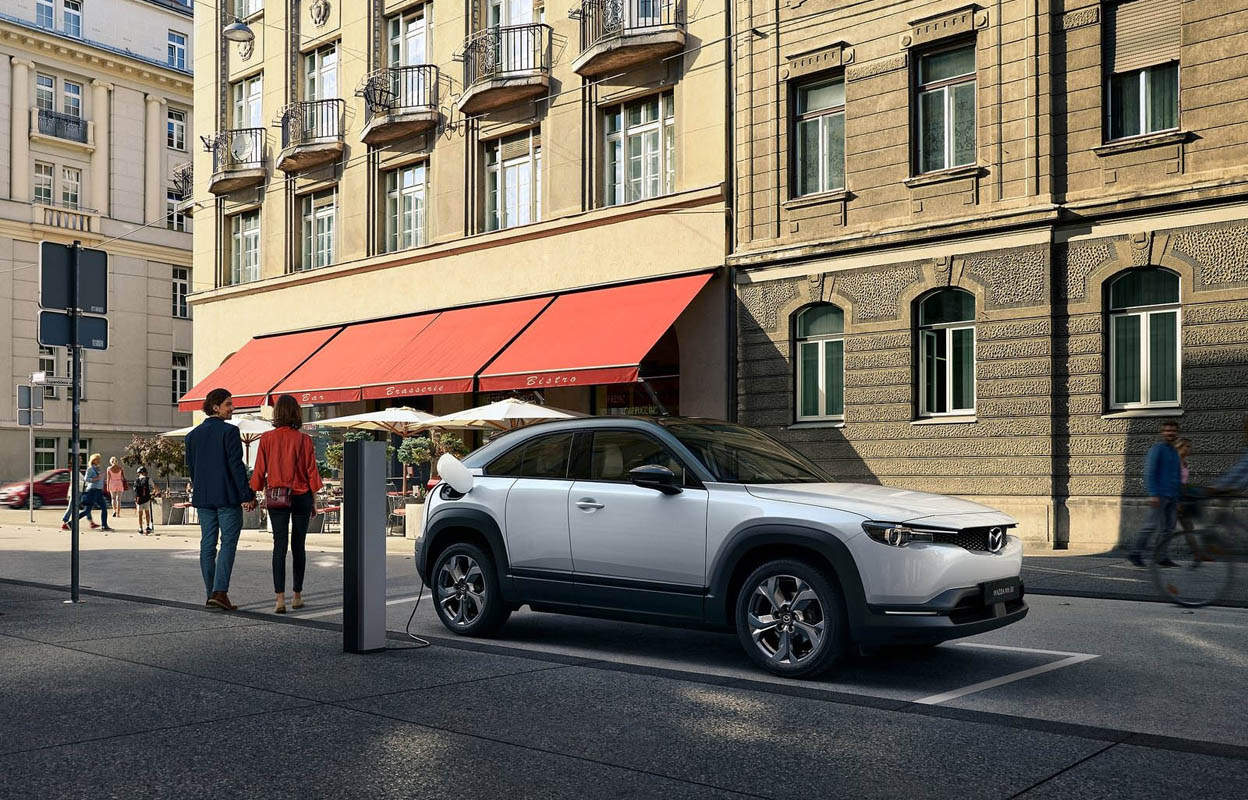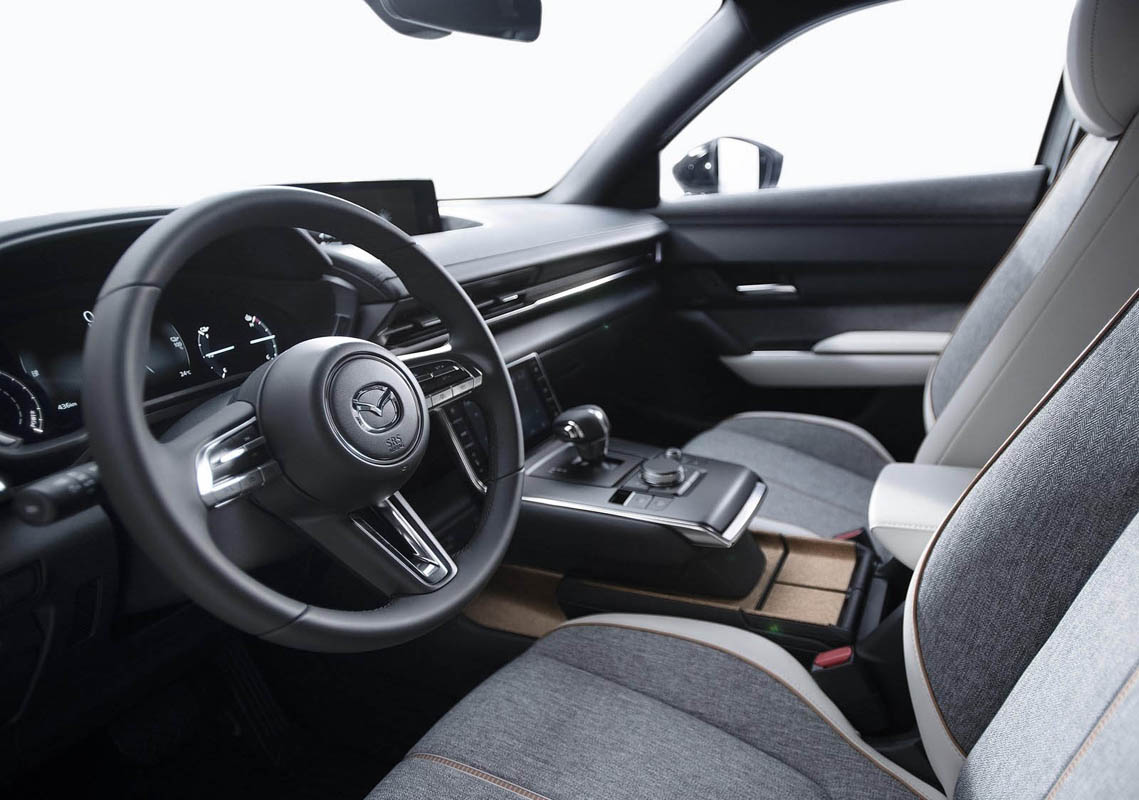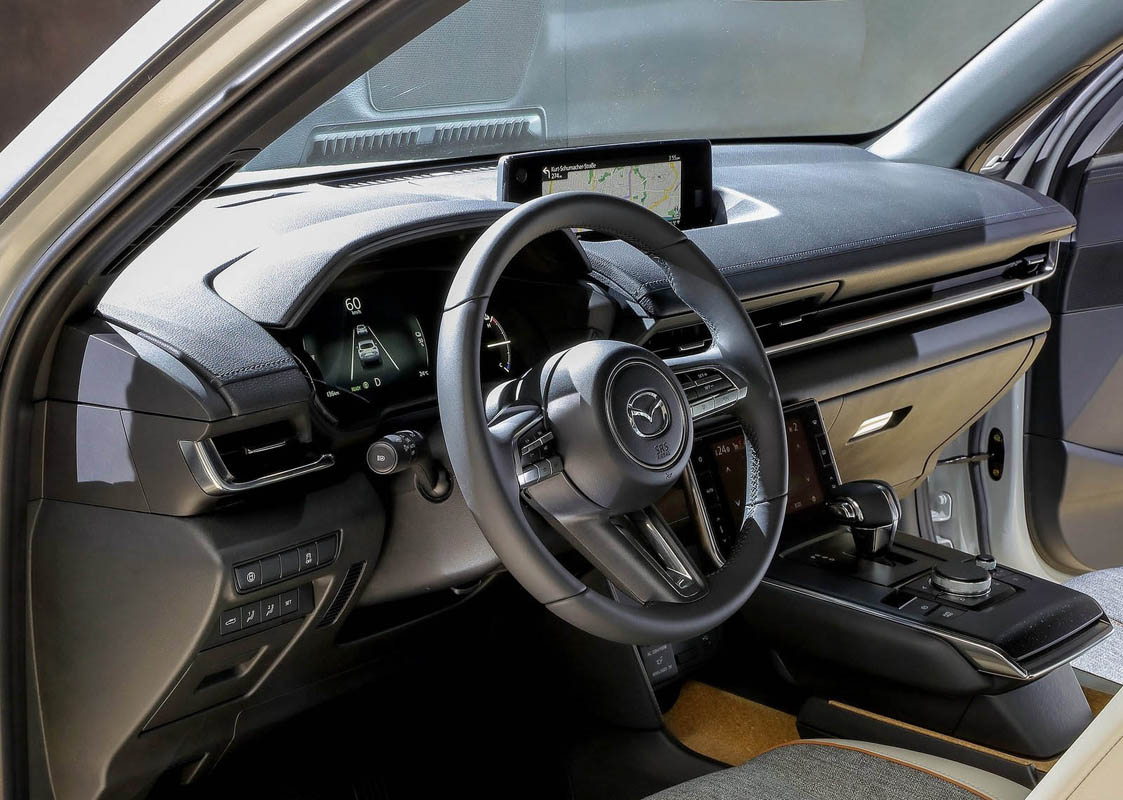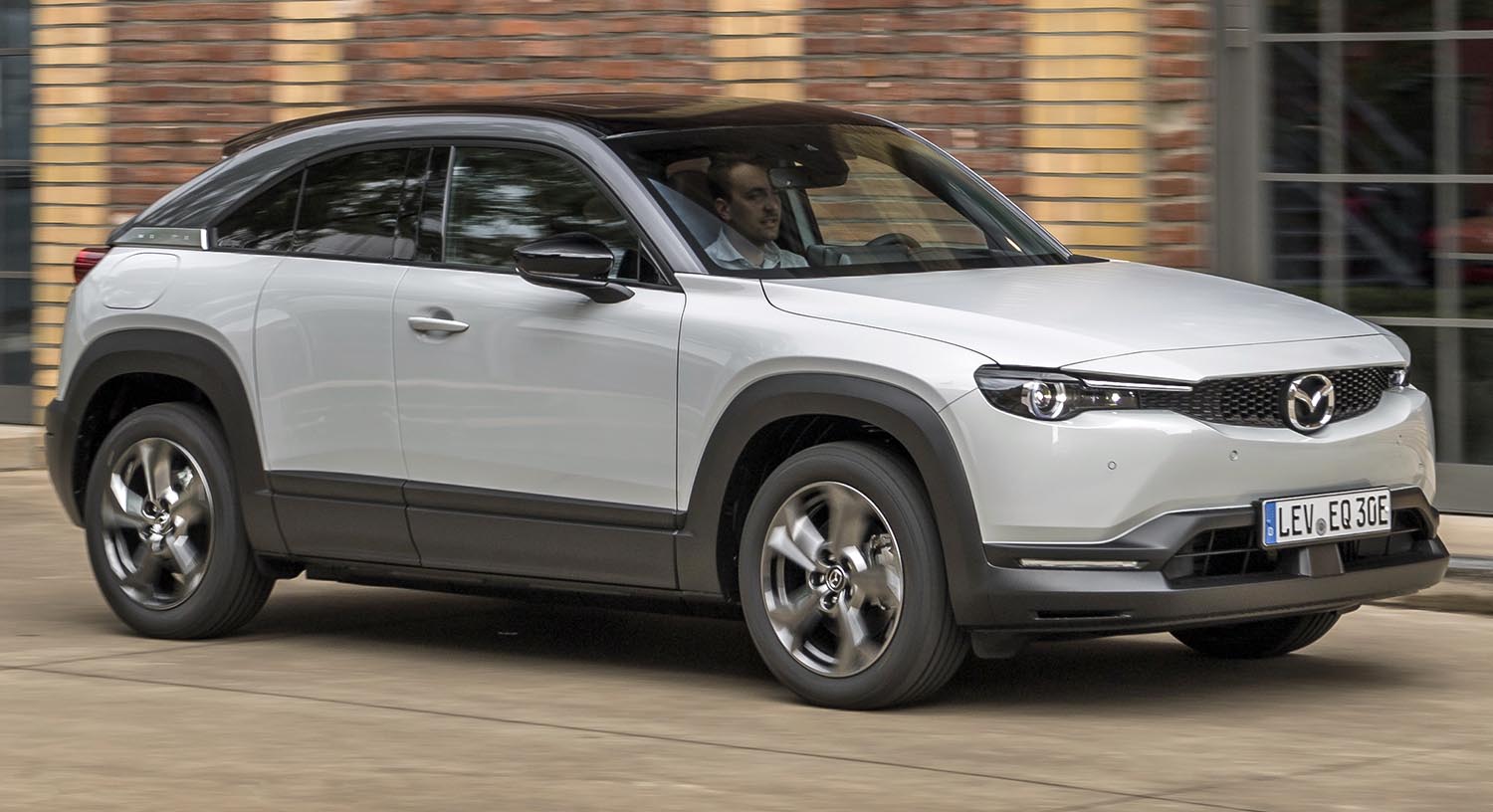
A look back though Mazda’s history reveals that the MX name actually pre-dates the world’s best-selling roadster, the MX-5, and has in fact been used more than a dozen times across a broad spread of production, concept and racing Mazdas.
These vehicle’s share the MX prefix because they have all taken on the challenge to create and deliver new values without being confined by convention, regardless of vehicle type. When it was revealed in 1989 the MX-5 was exactly this kind of car – as the automotive industry moved away from the affordable sports car, Mazda defied convention to create a perfect modern reinterpretation of the classic rear-wheel drive roadster.
Revealed in 1981, the first Mazda to wear the MX badge was the MX-81 concept car. This futuristic wedge-shaped hatchback was created by Italian styling house Bertone, and its high-mounted tail lights and pop-up headlamps were to appear in future Mazda models.
Unique features of the 1983 MX-02 concept included rear wheel steering and a windscreen head-up display, whilst the 1985 MX-03 concept went several steps further with an aircraft-style yoke rather than a wheel, digital displays, four-wheel steering and all-wheel drive, and a triple rotor 315PS engine.
First seen at the 1987 Tokyo Motor Show, the rotary engined MX-04 boasted two sets of removable fibreglass body panels, allowing owners to choose between a glass dome-roofed coupe or a beach buggy-style open sided roadster. Just two years later, the MX-5 arrived. The next cars to wear the MX badge were production models: the 1992 MX-3 coupe hatchback sported the world’s smallest V6 engine, and the larger MX-6 offered big coupe style for family saloon money.
The banning of rotary powered cars after the Mazda 787B took victory in the 1991 Le Mans 24 Hours spawned he most radical car to wear the MX badge in the 1990s – the MXR-01 prototype race car, of which just five examples were built. Sadly, the 1992 collapse of the World Sportscar Championship for which it was built denied the MXR-01 the chance of success, and spelt the end of Mazda’s world level motorsport programme.
The 2001 MX-Sport Tourer was a radical concept with freestyle doors, and the 2004 MX-Flexa concept introduced the world to the Sliding doors of the Mazda5 production car. The 2002 MX-Sport Runabout and 2003 MX-Sportif concepts previewed the second-generation Mazda2 and new Mazda3 respectively. The 2004 MX-MicroSport was a US-focused hatchback concept, whilst the 2005 MX-Crossport concept paved the way for a lineage of award-winning SUVs that lead to today’s CX-5 and CX-30.
Now, with the arrival of the Mazda MX-30, it’s appropriate that the MX name returns to a production model. As Mazda’s first production EV, the MX-30 is a car that represents a new chapter in Mazda’s history.

AN ELECTRIC CAR FOR BOTH THE DRIVER AND THE ENVIRONMENT
While retaining the beautiful, handcrafted forms of Kodo design, the styling of the Mazda MX-30 is further inspired by the ‘Human Modern’ concept – an exploration of a more expressive design direction which focuses on emerging new values and lifestyles.
This ‘Human Modern’ concept spurred numerous unprecedented design approaches. The exterior is uncompromisingly simple to emphasize its beauty as a solid mass, while its freestyle doors and framed glasshouse hint at the open, airy and spacious feeling of the cabin within.
The interior is designed to give occupants a sense of being ‘enveloped in openness’, and features a floating centre console and unique materials designed to minimize environmental impact.
A CABIN OF FINE CRAFTSMANSHIP AND ENVIRONMENTALLY-FRIENDLY MATERIALS
The design team paid particular attention not only to the selection of the right materials within the cabin but also to showing them in ways that bring out their best.
For instance, the heritage cork used in the centre console tray is designed to emphasize the texture and visual warmth of the material. And the door trim features a fibrous material with a texture that seems to contain air, reinforcing the sense of openness within the cabin at an unprecedentedly detailed level.
Both of these materials are designed to be low-impact and sustainable. The door trim uses fibres made from recycled plastic bottles and the cork is harvested from the bark of trees without felling. In addition, Mazda is replacing real leather upholstery with a vegan alternative.
For the first time in a Mazda, the MX-30 adopts a touch-screen air-conditioning control panel on a 7-inch screen in the lower centre console. The controls are simply displayed and intelligently grouped for safe and intuitive operation.
From materials to functionality, and from technology to design, all the cabin elements work together to create a space that encourages peace of mind from the moment customers open the door and throughout the driving experience, right up until they exit the vehicle.
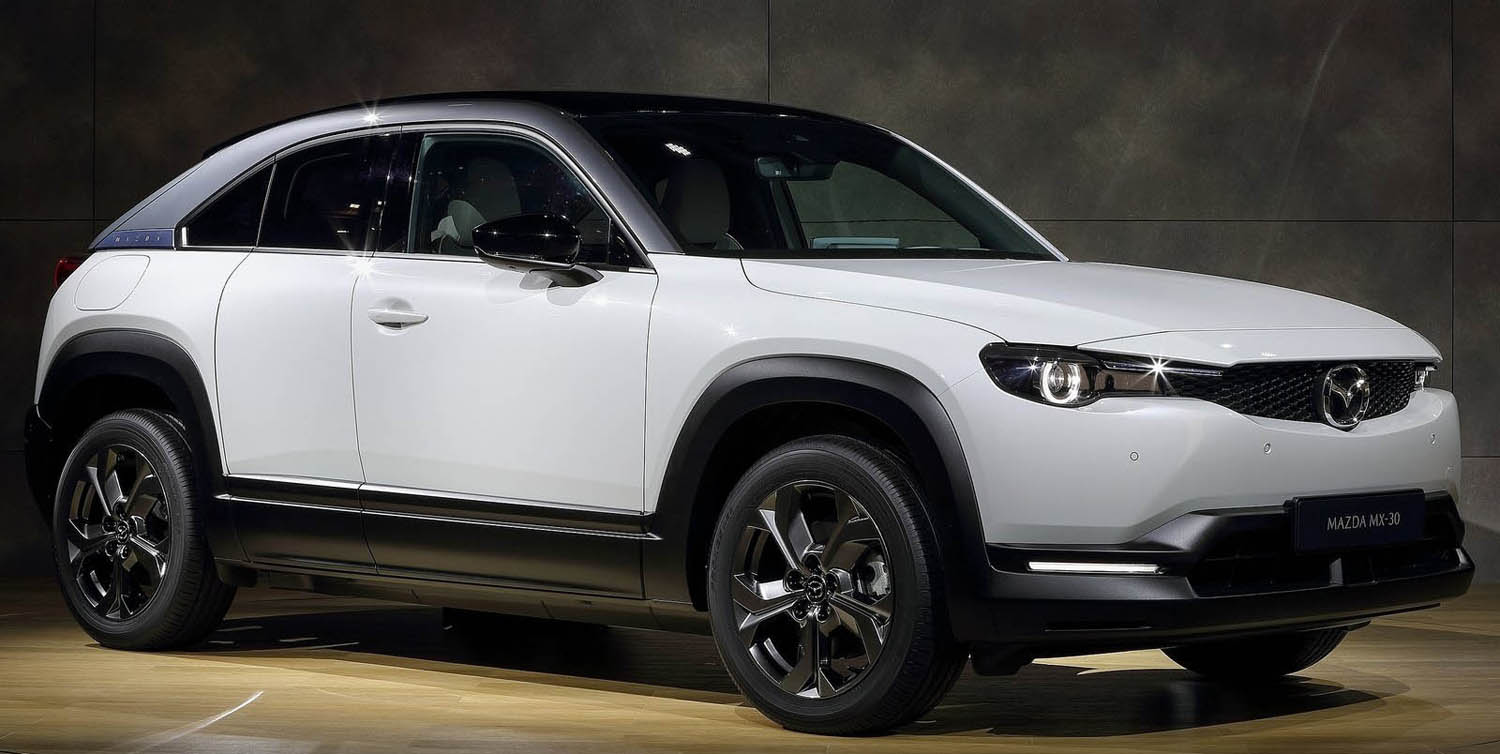
AN ENGAGING DRIVING EXPERIENCE
Mazda wants to enrich people’s lives through the car ownership and driving experience. The company envisions cars existing sustainably with the earth and society, and is committed to embracing, tackling and solving new automotive challenges through creative, forward thinking. This is the core of the Mazda vision.
The Mazda MX-30 introduces a new electric drive technology to Mazda, called e-Skyactiv. With a maximum system power of 107 Kw/145 PS and a maximum torque output of 270,9 Nm, the front-wheel drive MX-30 will accelerate from 0-100 km/h in 9.7 seconds.
Consuming 19 kWh/100km (CO2 emissions 0 g/km; WLTP combined), the e-Skyactiv system’s 35.5kWh lithium-ion battery equips the Mazda MX-30 with a WLTP measured driving range of 200km, far exceeding the 48 kilometres average daily drive of European customers.
Furthering the human-centric engineering philosophy that has spawned new technologies such as Skyactiv-Vehicle Architecture, the multi-directional ring structures of the bodyshell have been adapted and electric G-Vectoring Control Plus (e-GVC Plus) adopted to fully exploit the unique characteristics and qualities of an electric vehicle.
Mazda has developed its own bespoke Motor Pedal concept for the Mazda MX-30 – a development of the traditional accelerator pedal which reduces vehicle response time to pedal inputs. In addition, aural feedback related to the torque status of the power unit is provided via the audio system, helping the driver to subconsciously control vehicle speed with greater precision. The MX-30 is also equipped with steering wheel-mounted paddle shifters to further enhance the enjoyment of EV driving.
Acting in combination, these systems are designed to enhance the consistency of vehicle response to control inputs, realise seamless transitions between G forces, and improve both agility and stability when cornering, resulting in even greater refinement of the Mazda driving experience.
ADVANCED SAFETY PERFORMANCE FOR ENJOYMENT AND PEACE OF MIND
Committed to a future society free of car accidents, Mazda works continuously to advance safety performance under the Mazda Proactive Safety philosophy.
The Mazda MX-30’s suite of i-Activsense advanced safety technologies is strengthened through new functionality added to the Smart Brake Support (SBS) system aimed at helping to prevent collisions at intersections, and Emergency Lane Keeping technology designed to help keep drivers on track on roads with curbs or discernible edges, even in the absence of lane markings.
Despite adopting freestyle doors with no centre pillar, the MX-30’s bodyshell combines high strength with efficient energy absorption for excellent collision safety performance. Mazda’s engineers have incorporated the latest technologies and development concepts, including a carefully designed structure to protect the high-voltage battery.
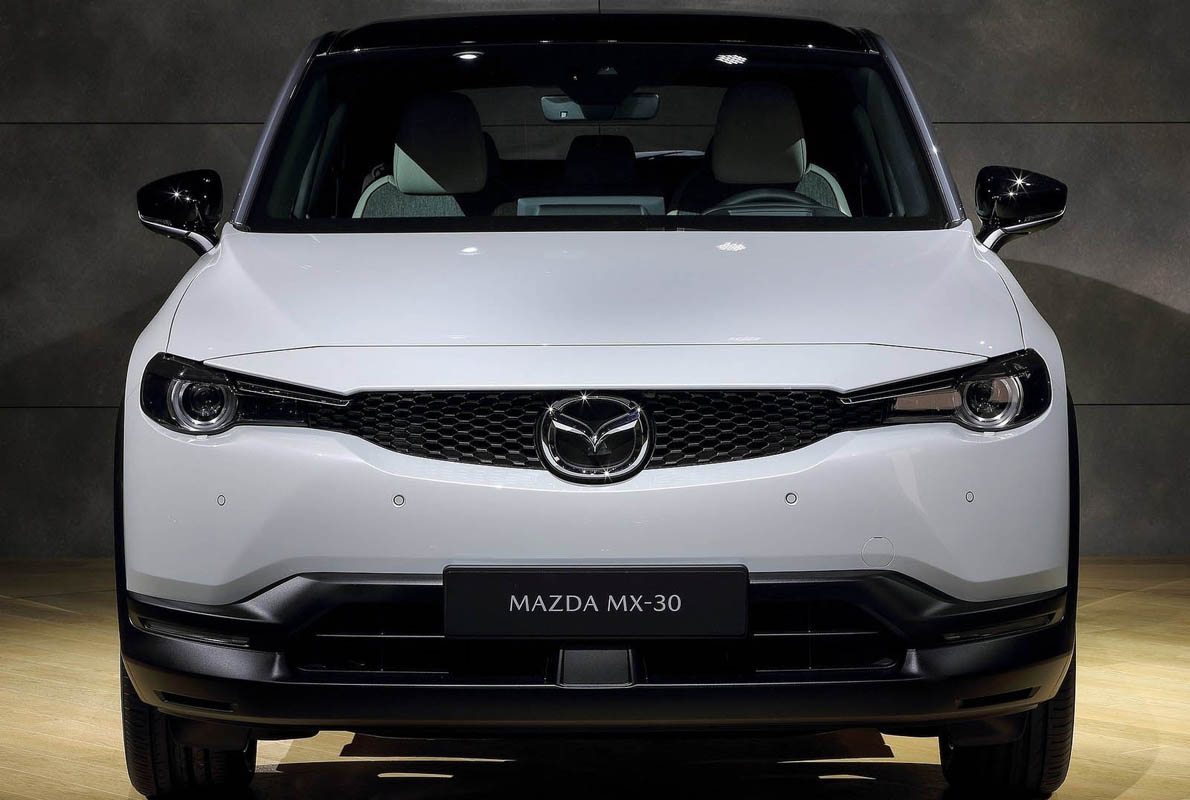
EXTERIOR DESIGN
The MX-30’s exterior design combines thoroughly modern flair with an impression of strength and elegance appropriate to an SUV. Concerted effort went into creating the latest expression of Kodo design – a pure look of solidity that reflects the beauty of shaving away all unnecessary elements. The natural presence of space within this strong, simple, yet meticulously crafted form establishes the exterior’s Human Modern credentials.
FRONT DESIGN
The frontal design serves as the starting point for generating the MX-30’s image as a solid mass which combines simplicity, strength and familiarity with dynamic vitality. Mazda has done away with the signature wing used on other products in its model line-up. Though the wing’s residual presence is still felt, all reflections and elements now converge on the central Mazda logo, which becomes the highlight feature of the front design.
Breaking new ground for Kodo design, this powerful new front grille styling combines with the deeply sculpted form around the headlamps to realize a front design which, though new, still exudes Mazda’s characteristic vitality.
SIDE DESIGN
The image of a strong, solid mass travels along the sides of the body as a consistent, extremely simple, large surface. Though they appear flat, the body side surfaces are in fact formed with a bold curve in them that continues from the front end to the shoulder highlights.
To add energy and movement to these simple forms, the A-pillars stand boldly upright to punctuate the flow with an effective ‘Charge and Release’ expression. And the C-pillars sweep down at a sharp angle to seamlessly blend the roof and cabin with the solid body mass at the rear.
FRAMED TOP AND COLOUR SCHEMES
The side frame sections of the cab between the A-pillars and C-pillars, as well as the side of the tailgate, are finished in a metallic paint colour distinct from the main body, emphasising both the cabin’s streamlined look and its integration with the rear of the vehicle. The roof itself is blacked out in order to further highlight the powerful sweep of the metallic-finish frame elements.
The framed top will be available in either a Silver or Dark Metallic finish, and combines with a choice of Soul Red Crystal, Polymetal Grey or Ceramic Metallic body colours to achieve both a sense of lightness and the powerful colour combinations appropriate to Human Modern design.
Alternatively, customers can choose between five standard body colours as a finish for the entire exterior: Polymetal Grey, Machine Grey, Arctic White, Ceramic White and Jet Black.
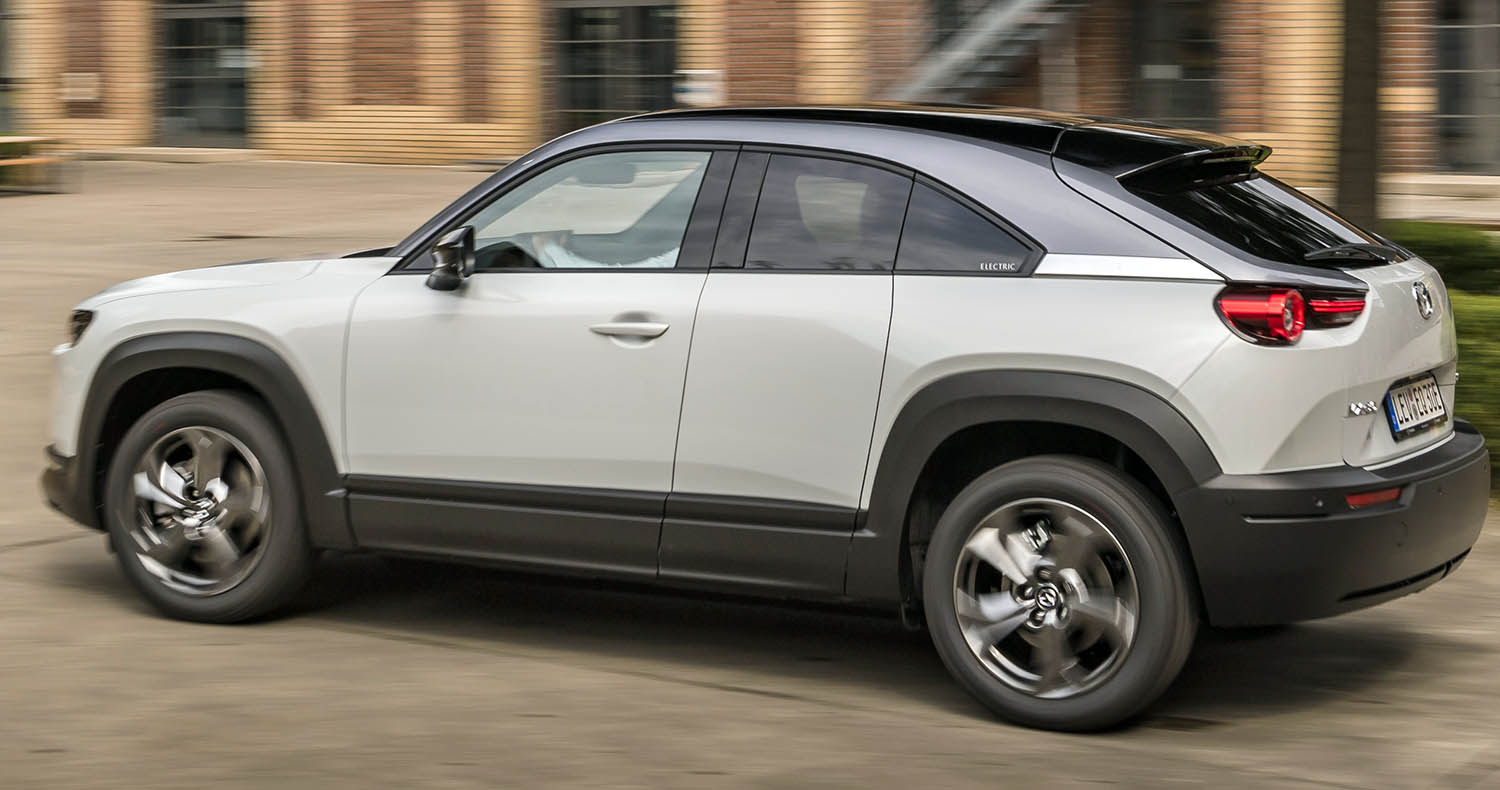
LAMP DESIGN
The same cylindrical headlamp design used on all Mazda’s new-generation cars combines depth with distinctiveness. To highlight the three-dimensionality of the rear combination lamps, the outer lenses adopt a design that follows the shape of the lamp housings.
INTERIOR DESIGN
The adoption of freestyle doors facilitating an interior layout that seems to wrap around occupants in a comfortable fashion, the Mazda MX-30 cabin employs the latest design solutions and technologies to create a spacious, open environment.
A range of new, environmentally-friendly materials have been carefully selected and meticulously finished. The result -an expression of the Human Modern design concept- is a stylish, comfortable interior conducive to peace of mind for every occupant.
FRONT SEAT SPACE
While remaining committed to Mazda’s characteristic, ergonomically excellent, driver-centric cockpit design, the MX-30 furthers the concept of the horizontal layout to give the interior a simpler, wider look.
One change implemented to create a look of greater simplicity within the cabin is the introduction of a 7-inch touch-screen air-conditioning control panel; a Mazda first. In addition, the floating centre console, the upper section of the instrument panel, the driver’s instrument binnacle hood and related trim are all designed to create a sense of continuity and lightness.
While these innovations have a functional value, they have also been developed to appeal to the senses, enhancing the perceived quality of the cabin environment. The design was subsequently honed through a collaborative effort with engineers using analytic data on human characteristics.
As a result, from the moment one of its doors is opened, the cabin exudes a strong impression of liberating spaciousness, while enhancing every occupants feeling of homogeny with the car.
REAR SEAT SPACE
The MX-30 takes advantage of its freestyle doors by using the side door trim for the rear seats to create an armrest design that resembles a couch, thus creating a cosseting rear seat ambience more akin to that of living room furniture.
FLOATING CONSOLE
An Mazda MX-30 highlight is the floating centre console that stands independent of the dashboard and surrounding interior components. Housing the new 7-inch touch-screen display, the floating design also adds additional storage space for the front seat occupants.
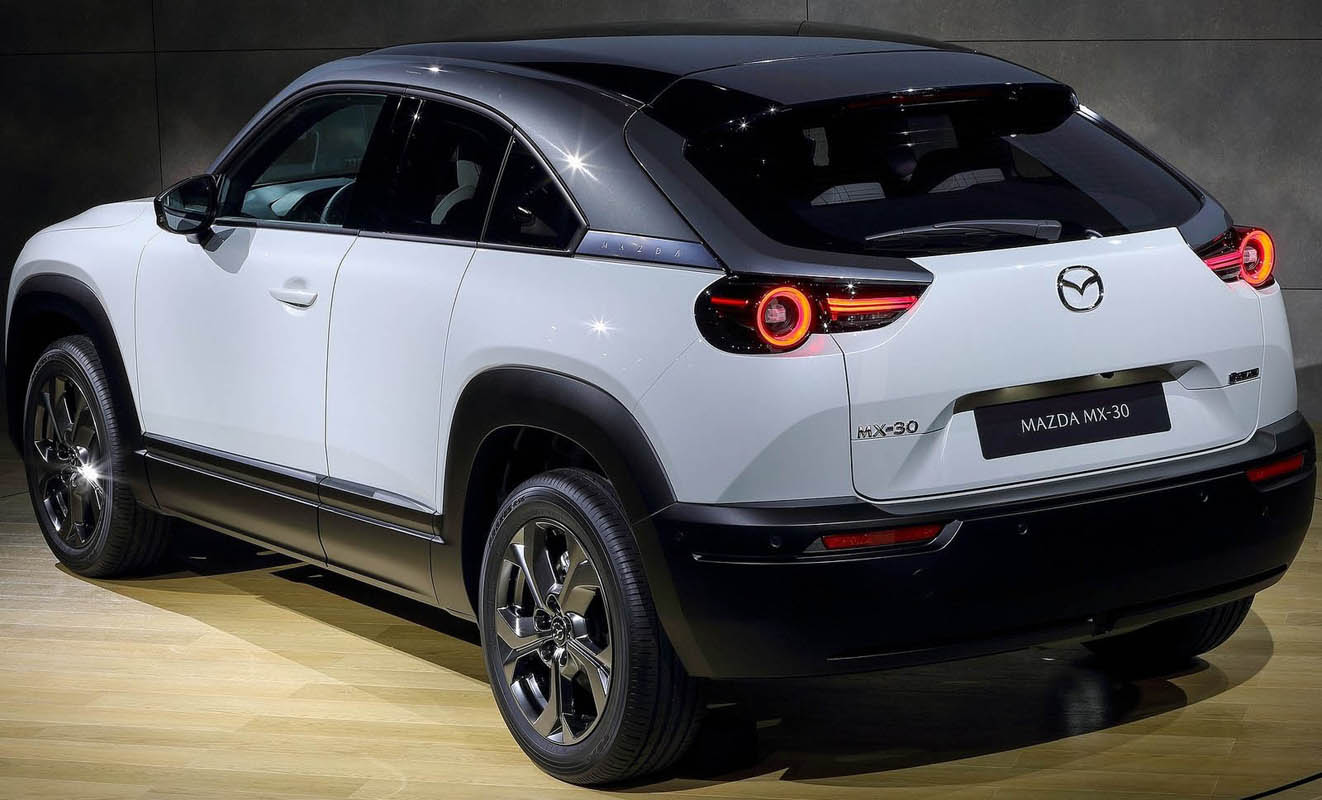
SUSTAINABLE MATERIALS, CRAFTSMANSHIP AND COLOURS
Development of materials and colours for the MX-30 focused on modern styling with a natural, high-quality appearance. Mazda also strove to use materials that show an even greater respect for environmental conservation, whilst striking a balance between sustainability and the natural appeal of the materials selected, and comfort, fit and finish.
HERITAGE CORK
Because no trees are felled and only the bark is stripped away to obtain the material, cork is a naturally derived product with low environmental impact. For the highest sustainability, the Mazda MX-30 features cork left over from the production of bottle stoppers. The material’s inherent warmth, gentle touch and cushioning are put to good use in the centre console’s tray sections as well as on the door grips.
To ensure the high level of durability required for use as car parts, Mazda developed a dedicated coating and a special technique to process the cork and its base material at the same time.
Cork also pays tribute to Mazda’s heritage, harking back to the company foundation in 1920 as the Toyo Cork Kogyo Corporation.
BREATHING FIBRE – AN EXCLUSIVE FABRIC
The upper section of the door is trimmed in a recycled fabric designed exclusively for its pile, density and colour. Different from previous applications of plastics or leather, the fabric contains air, providing a soft touch and reinforcing the sense of openness within in the cabin. Reducing the Mazda MX-30’s ecological footprint, the fabric is made from recycled PET bottles. Development of a new method for the integrated moulding of textile and plastic fibres made it possible to create a material with a soft touch that can be processed easily.
COLOUR-COORDINATION WITH RECYCLED FABRIC AND ARTIFICIAL LEATHER
The MX-30’s interior colours have been coordinated to combine a rich range of variations with both functional and visual appeal. Parts of the seat with which the occupant makes direct contact are fabric covered, while the seat backs are finished in artificial leather.
Some of the colour-coordinated seat fabrics use up to 20% recycled thread, while maintaining tactile appeal and a high quality appearance.
The interior is available in a choice of two colour schemes: Modern Confidence – a bright, modern look that pairs white leatherette with melange toned fabric, orange seat stitching and a natural cork finish; and Vintage Industrial – a vintage look that pairs brown leatherette with 20% recycled, denim coloured fabric and a darker coloured cork finish.
Mazda’s new Premium Vintage Leatherette belies the conventional wisdom that artificial leather is merely a poor substitute for the real thing. Developed for the MX-30, it features a vintage leather texture printed onto a high-quality artificial leather base. A silicone coating with a precisely-controlled surface layer thickness is then applied, giving the material an appearance of depth and a pleasing tactile quality. This artificial leather is produced using water rather than organic solvents, helping to reduce its environmental impact.
Customers opting for the standard MX-30 interior are offered a combination of high-quality Black and Light Grey fabrics paired with natural tone cork.
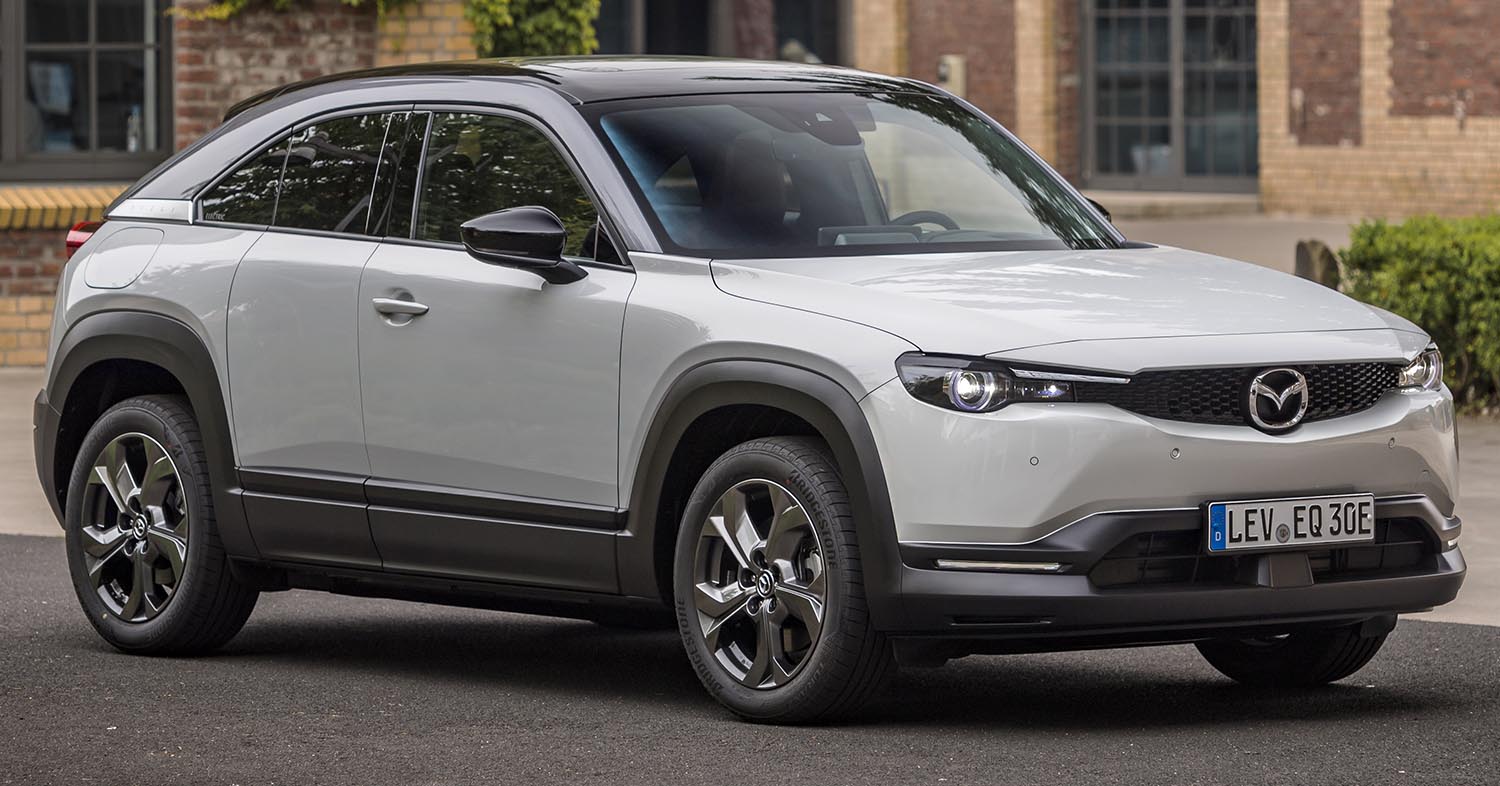
PACKAGING
Mazda wants its customers to make their car a place in which they can relax, and an experience that enriches their daily routines. To achieve this, the interior of the Mazda MX-30 combines functionality based on the latest research into psychology and ergonomics with the design goal of occupants being ‘enveloped in openness’.
The company’s characteristic driving environment lies at the heart of every Mazda, building on human-centric design to achieve ergonomic excellence, the ideal driving position and effoltress implementation of the vehicle’s Human-Machine Interface (HMI).
FREESTYLE DOORS
The MX-30 features centre pillar-less freestyle doors with custom-designed hinges. The front doors open forwards to an angle of up to 82° and rear doors backwards, to 80°.
The large resultant aperture allied to the absence of a centre pillar ensures the easiest possible entry to and exit from both front and rear seats, as well as far simpler loading and unloading of cargo.
The height and shape of the door openings have been designed in accordance with human characteristics. The rear door trim incorporates a vertical grip that makes opening and closing the door easier, with less burden on the wrist, even with the door wide open.
The front seats are equipped with a walk-in mechanism that, with a single touch, folds the seatback forward and simultaneously slides the whole seat toward the front, ensuring smooth entry to and exit from the rear seats. The cross-section of the side sills and shape of the side sill garnish are also carefully designed to facilitate smooth, effoltress exit from the cabin.
VISIBILITY
The Mazda MX-30’s seating is set higher to secure a clear and unobstructed view. The clear view of the bonnet from the driver’s seat makes it easier for the driver to gain a clear sense of the vehicle’s extremities and place it accurately on the road; an asset when driving on narrow roads or in parking lots.
The shape of the rear door glass and quarter windows was carefully designed in accordance with studies on human characteristics. This enables drivers to turn their heads in place and clearly see vehicles diagonally behind the Mazda MX-30, allowing him or her to change lanes or back up with increased safety.
COMFORT
To create a sense of being ‘enveloped in openness’, the front seats of the Mazda MX-30 are separated by a floating console. This not only creates a useful open space between the left and right sides, but also has been carefully designed to enhance a sense of togetherness connecting driver and passenger for a more pleasing and communicative driving experience.
The rear door glass and quarter windows are positioned to enable rear seat occupants to look out from a natural seated position, while the rounded space created by the doors, side trim and rear seats is designed to convey a feeling of being wrapped in reassuring comfort.
LUGGAGE SPACE
The 366 litre luggage compartment is designed to provide adequate space for all manner of family lifestyles. A sub-trunk beneath the floor offers additional space for storing small items. The height of the tailgate lower lip is designed in accordance with human characteristics to make loading and unloading luggage items easier.
The loadspace itself space is roomy and cleanly finished. Care has been taken with every detail, such as minimising the height difference between the loadspace floor and the rear seatbacks when they are folded down to make the space as easy to use as possible.
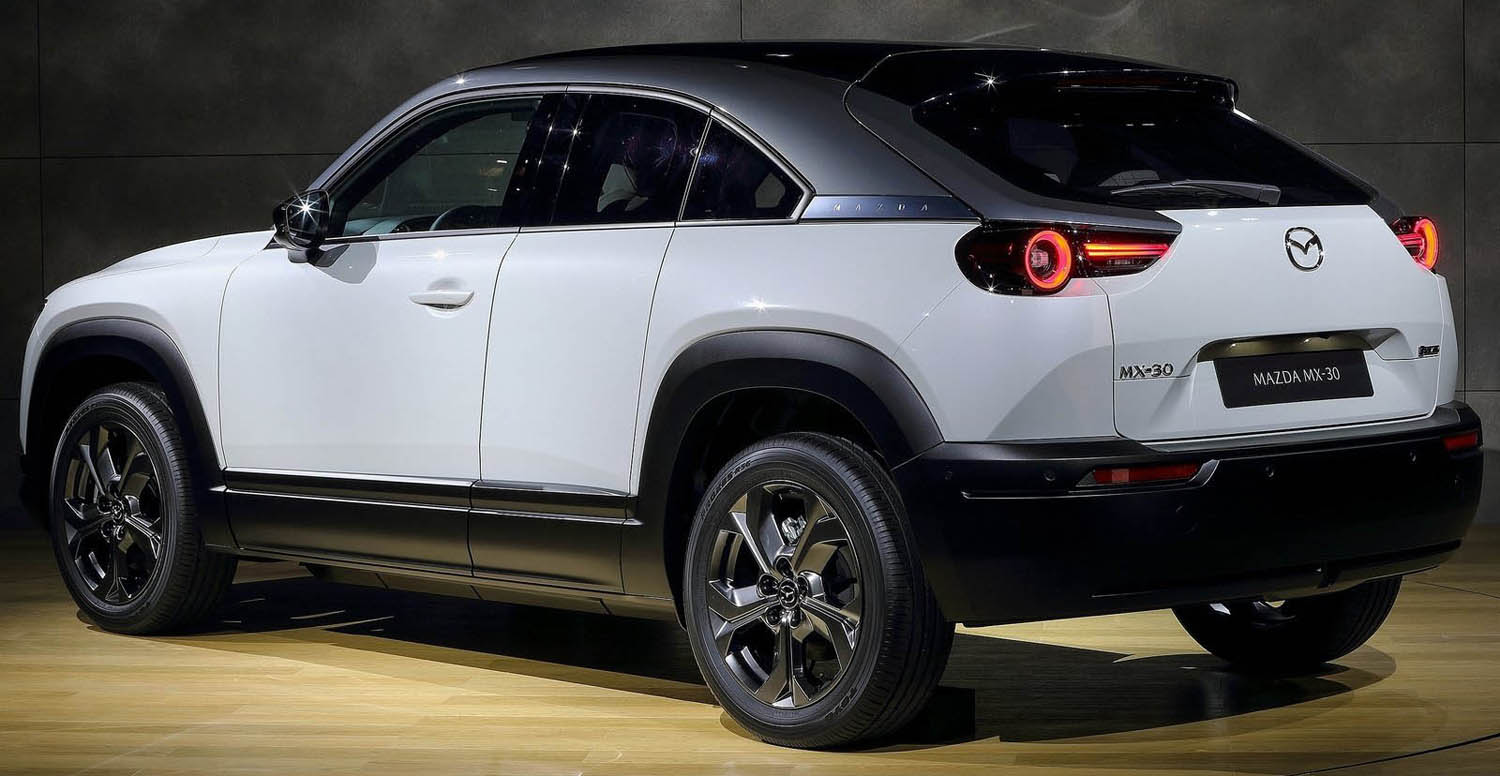
DRIVING POSITION
The MX-30 shares the same carefully considered cockpit design found on all Mazda cars, with a horizontally symmetrical layout centred on the driver. It offers an ergonomically excellent driving position that feels natural and supportive, and allows the driver to focus on road and traffic ahead.
The steering wheel offers a 45 mm vertical and 70 mm horizontal tilt and telescopic adjustment range. And the driver’s seat on all model grades features slide, lift, recline and cushion tilt adjustment mechanisms to provide the ideal driving position to the widest possible range of driver physiques.
7-INCH TFT INSTRUMENT CLUSTER DISPLAY AND HEAD-UP DISPLAY
The driver’s instrument cluster incorporates a central, 7-inch TFT LCD display. This provides drivers with a variety of information in a clear, condensed fashion, allowing them to understand it instantly with minimum visual distraction. Fitted as standard, the windscreen-projected head-up display shows all relevant driving information directly in the driver’s line of site to minimise distraction from the road ahead.
FLOATING CONSOLE
The shift lever and commander control are positioned toward the front of the console and the centre armrest is high so these controls can be operated with the arm at a natural angle. The centre armrest also adopts a slide mechanism, affording all drivers a comfortable posture, regardless of build.
Cupholders are positioned in the deeply recessed area between the shift lever panel and the centre armrest. The height of the armrest makes both putting drinks in the cupholders and operating the commander easy and natural. An opening in the lower area at the front of the console offers additional storage space.
7-INCH TOUCH-SCREEN DISPLAY
A Mazda first, the MX-30 features a 7-inch touchscreen display at the front of the centre console. When the driver opens the door and gets into the car, a graphic appears on the screen, subtly changing appearance depending on the time of day and temperature to create a unique mood for each drive. Once the car is switched on, the screen displays the air-conditioning controls.
TOUCH-SCREEN AIR-CONDITIONING CONTROLS
The 7-inch display serves as a touch-screen air-conditioning control panel, offering controls for temperature, airflow and seat heating. All controls are displayed in simple fashion and functions are grouped intelligently so that all operations can be performed quickly and intuitively.
The air-conditioning system is programmed so that a quick tap of the screen will adjust the temperature by an increment of 0.5 degrees, whilst a swipe of the finger will alter it in steps of 3 degrees. The screen area that responds to touch is slightly larger than the graphic itself, helping shorten the time the driver needs to look at the screen. And the system also provides audible feedback to confirm that each action has been completed.
Push switches mounted on the display’s perimeter offer alternative control over A/C on-off, auto control, temperature adjustment, fan speed and window demisting. These switches are designed to be easily operable, even when the user is wearing gloves.
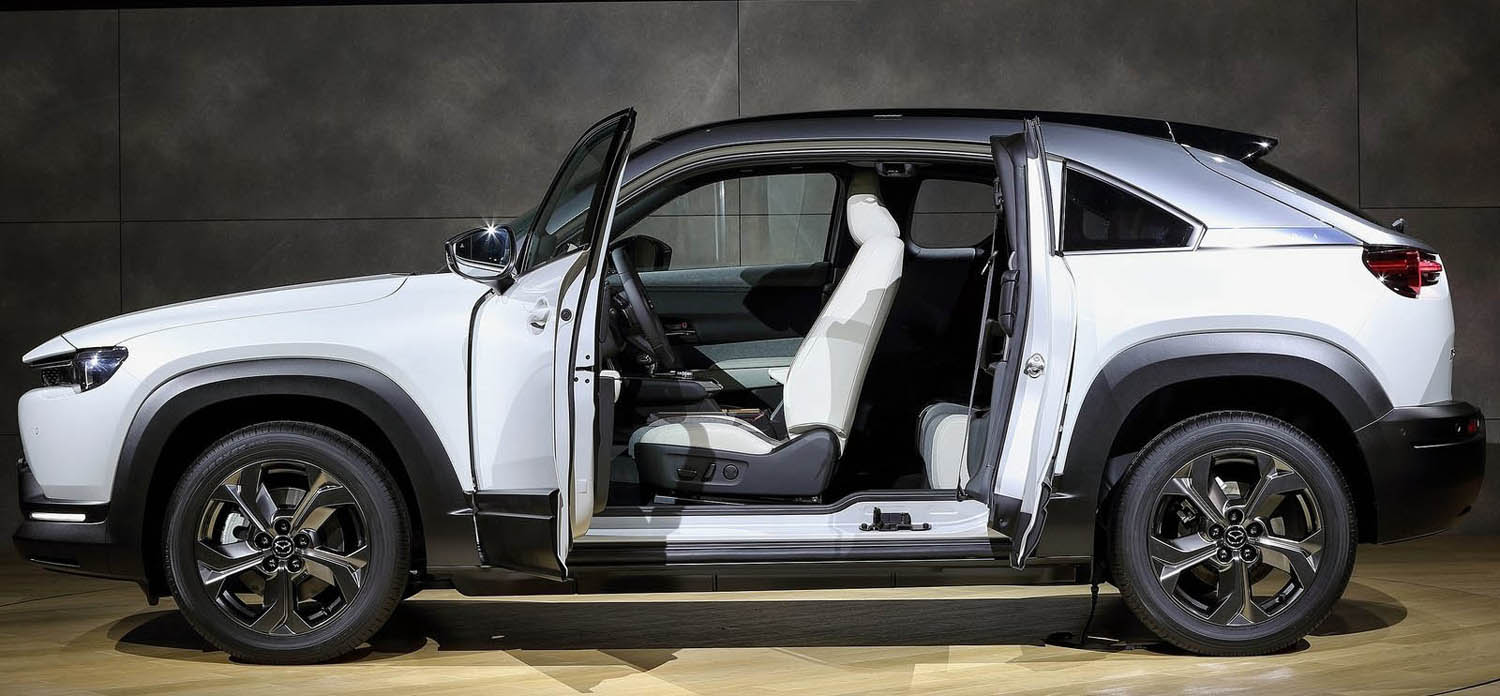
8.8-INCH CENTRE DISPLAY
The Mazda MX-30 adopts the same 8.8-inch, dashtop-mounted centre display introduced in the Mazda3 and CX-30. In addition to a two screen configuration that uses the widescreen format to make the device even easier to use, content is displayed in the same font as on other on-board devices such as the gauges, giving visual consistency of instrumentation throughout the cabin.
Mazda’s Commander Control knob offers fast, easy and intuitive control of the system, ensuring drivers quickly learn to operate it without the need to look down.
MAZDA CONNECT WITH APPLE CARPLAY AND ANDROID AUTO
The Mazda MX-30 features the latest version of Mazda Connect, which includes enhancements such as a quicker start up, improved image and sound quality, a built-in 3D gyro sensor, and a free word search function that lets users search for destinations by entering a combination of keywords.
As in all new Mazda models, the system supports Apple CarPlay® and Android Auto™, as standard, via USB connection to ensure a convenient user experience with smart phone integration.
DEDICATED EV SERVICES AND NEW FUNCTIONS ON THE MYMAZDA APP
The Mazda MX-30 will see the introduction of new functions and services that will make life with an electric vehicle even more convenient. Mazda plans to add functions that are only possible with an electric vehicle, such as notification to a customer’s smartphone if they forget to plug in the charging cable, the ability to control charging using a timer, monitor charging progress, view the status of the battery and adjust vehicle climate control settings via the MyMazda smartphone App.
Amongst the EV functions of the new MyMazda App is remote setting of the charging process, a range indicator, battery status, low battery warning messages and the ability to search for charging stations and relay the information to the navigation system.
Further general functions include the remote control of the air-conditioning – including windscreen ventilation and rear screen heating, remote control of the door interlock system, vehicle status – such as tyre pressures, door locking, etc, warning messages and a Send Route to Car navigation aid.
POWER SUPPLIES
The Mazda MX-30 offers numerous power supplies, including a pair of 2.5A USB ports and a 12V DC power socket fitted, as standard, at the front of the floating console, for the charging of smartphones, tablets etc. Certain model grades also include a 150W AC outlet to charge larger devices.
SHIFTER
The Mazda MX-30 powertrain adopts electronic gear shifting. In keeping with Mazda’s philosophy of placing top priority on safety, the MX-30 uses the same design as the company’s conventional automatic transmission (AT) shifters – meaning the lever locks into each of the P-R-N-D positions, making it easier to determine what gear the vehicle is in at any given time.
The shift pattern puts D (Drive) at the back, R (Reverse) at the front and P (Park) offset to the side at the front. This intuitive and simple layout offers sure and safe operation.
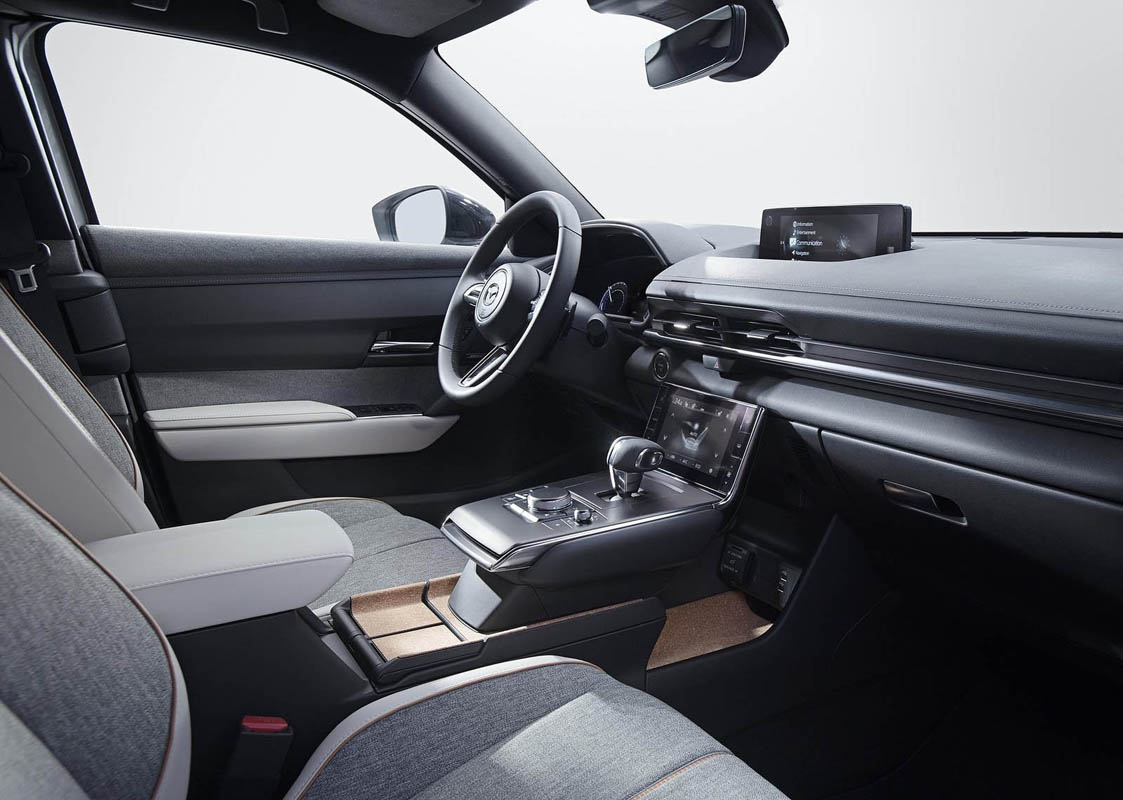
MAZDA HARMONIC ACOUSTICS AND BOSE SOUND SYSTEM
The Mazda MX-30 may be equipped with a choice of two high quality sound systems – the unique Mazda Harmonic Acoustics system or an optional 12-speaker Bose premium sound system.
MAZDA HARMONIC ACCOUSTICS
The Mazda Harmonic Acoustics system features speakers perfectly positioned to produce the best sound and reach the human ear as easily as possible in the cabin environment. Uniquely, it features 3L woofers positioned in the sides of the front cowls rather than the front door panels, as well as 2.5 cm tweeters in the left and right sail garnishes and 8 cm squawkers on the upper section of the front and rear door trims.
BOSE SOUND SYSTEM
The optional Bose 12-speaker premium audio system offers another level of sound performance and listening pleasure – using the innovative Bose BassMatch system configuration to deliver deeper, more impactful low-frequency reproduction along with clearer audio performance throughout the cabin.
The BassMatch configuration combines a pair of low-frequency enclosures, placed near the kick panels in the front cowls, with a third bass source positioned in the rear of the vehicle. This layout generates more acoustic energy and reduces buzz and vibrations even when playing music at high volumes.
The Bose system also includes mid-range drivers in each door and in the centre of the instrument panel for smooth sound distribution. High-frequency tweeters in each mirror patch and rear surround speakers located in each C-pillar complete the package and help deliver balanced sound for all occupants.
Advanced Bose technologies, including Centerpoint surround signal processing, AudioPilot noise-compensation technology, and selectable listening modes help ensure a closer connection between passengers and their music inside the new Mazda MX-30.
EV TECHNOLOGY AND DRIVING DYNAMICS
Key to Mazda’s philosophy of the right power source in the right place at the right time, the company’s ‘well-to-wheel’ approach to emissions measurement concerns not only the CO2 emitted by cars themselves whilst driving, but also the emissions caused by the extraction and refinery of fuel, or the generation of electricity.
Moreover, in the context of EVs and the batteries they use, Mazda considers it important to consider the need to reduce CO2 emissions over their entire life cycle.
Life-Cycle Assessment (LCA) is a technique designed to measure – in addition to well-to-wheel emissions – the total environmental impact of a product over its entire life, from the extraction of the raw materials necessary for production through to end-of-life disposal.
Following a study by Mazda and the Kogakuin University which has been published in the Sustainable Science magazine , the company’s LCA research has shown that, over their entire life cycle, EVs with smaller batteries tend to produce lower CO2 emissions than comparable diesel-engined cars. To that end, Mazda believes that the MX-30’s battery capacity of 35.5 kwh provides the optimum balance between a driving range which gives customers peace of mind and CO2 emissions from an LCA perspective.
Furthermore, this keeps overall vehicle weight lower for good handling and greater agility, which is currently not the case for many EVs.
HUMAN-CENTRIC DESIGN DELIVERS A PURE DRIVING EXPERIENCE
Every Mazda is designed to deliver outstanding driving pleasure based on the company’s unique Jinba Ittai – driver and car as one – engineering ethos. With the 2019 launch of the latest Mazda3, the company introduced its latest Skyactiv-Vehicle Architecture, a set of next-generation structural technologies which focus on the further evolution of Mazda’s human-centred development philosophy.
As the third newcomer in Mazda’s next-generation model line-up following the Mazda3 and the CX-30, the MX-30 adopts this advanced technology. It is designed to offer a pure, unique Jinba Ittai driving experience uniquely tailored to the smooth behaviour and seamless operation of its all-electric powertrain.
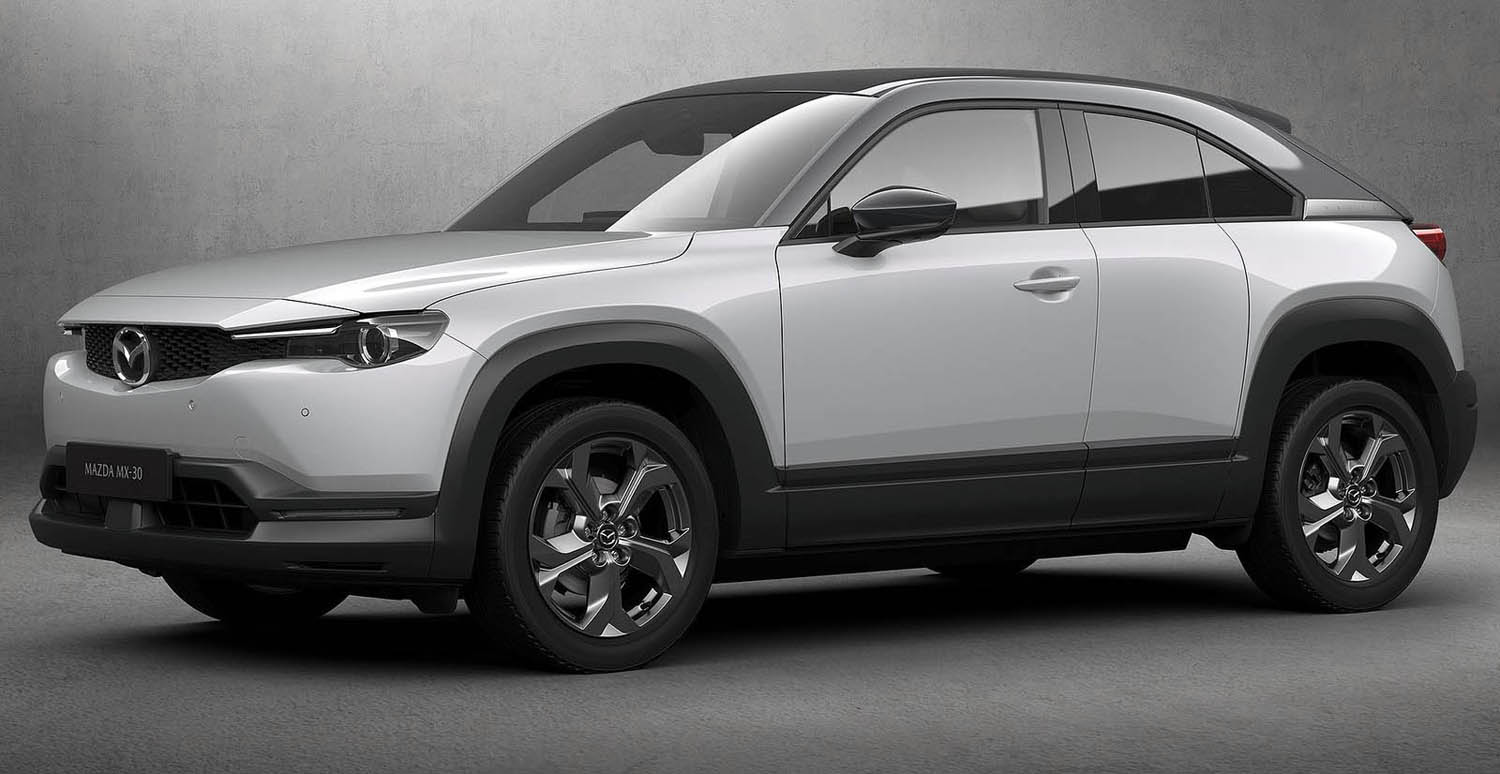
ENHANCED JINBA ITTAI DRIVING EXPERIENCE
The goal of the Jinba Ittai driving ethos is to make the car’s reaction to the driver’s intention instantaneous, so that man and machine move together as one, providing faithful response, greater confidence, and enhanced safety.
The ongoing quest for the ultimate Jinba Ittai driving experience has led to the birth of technologies that use Mazda’s human-centric development philosophy to maximise the potential of human abilities.
Both the multi-directional ring structures of the bodyshell and G-vectoring control (GVC) were evolved to fully exploit the unique characteristics and qualities of an electric vehicle. Mazda has also developed its own bespoke motor pedal concept for the Mazda MX-30 – a development of the traditional accelerator pedal. The MX-30 is also equipped with steering wheel-mounted paddle shifters to further enhance the enjoyment of EV driving.
These technologies combine to offer drivers a composed ride quality, seamless vehicle motion in all directions, and an intuitive feeling of total control over all driving operations, as if the car is an extension of driver’s body – a further evolution of the Jinba Ittai driving experience.
E-SKYACTIV ELECTRIC-DRIVE TECHNOLOGY
The MX-30’s new e-Skyactiv electric-drive technology combines a lithium-ion battery pack and electric motor with technologies born of Mazda’s human-centric development philosophy. It offers drivers a uniquely smooth, quiet and seamless all-electric driving experience in which the car faithfully and directly responds to the driver’s intentions.
SYSTEM CONFIGURATION AND PERFORMANCE
The e-Skyactiv system’s high-voltage components include the motor, battery pack, inverter, and DC-DC converter. The inverter converts direct current from the battery to alternating current to drive the motor, while the DC-DC converter steps down the voltage to supply power to the car’s 12V auxiliary equipment.
The motor, inverter, DC-DC converter and junction box are integrated into a single high-voltage unit that is mounted toward the front of the car. The size of the high-voltage battery mounted beneath the floor was carefully chosen to minimise CO2 emissions throughout its life cycle, from resource extraction through to battery disposal.
The motor is a water cooled AC synchronous unit with a maximum power output of 105 Kw and maximum torque of 265 Nm. The prismatic cells of the 355 V lithium-ion system battery generate a total electric power output of 35.5 kw.
To reduce its height and minimise its intrusion on cabin space, the battery pack features a high-density battery module, thin busbar wiring to reduce the size of wiring between high-voltage parts, and a thin cooling system.
The battery case is rigidly integrated into the Mazda MX-30 bodyshell to enhance overall vehicle stiffness. And both normal and rapid charging ports are packaged together and accessed from the right rear fender, with the onboard AC charging cable stowed in the luggage area.
A control scheme minimises energy loss throughout the system, including loss from the inverter, the motor and in converting battery power into drive power. This combines with harmonious control between the system and the vehicle to reduce power consumption and maximise the amount of energy that goes directly towards powering the MX-30.
With a maximum system power of 107 kw/145 PS and a maximum torque output of 270,9 Nm (WLTP combined electricity consumption 19 kWh/100km, CO2 emissions 0 g/km) , the front-wheel drive MX-30 will accelerate from 0-100 km/h in 9.7 seconds and has a governed maximum speed of 140 km/h. Consuming 190 wh/km/19 kwh/100 km (WLTP combined), the MX-30’s WLTP measured driving range of 200 km far exceeds the 48 km average daily drive of European customers .

BATTERY COOLING SYSTEM
The Mazda MX-30 battery pack features a refrigerant cooling system that cools the battery pack when the temperature rises. The compact system adopts thin cooling tubes attached to the bottom plane of the battery module, which make contact with a heat exchanger. A sensor constantly monitors the battery’s temperature and controls the flow of coolant as needed.
By maintaining the best possible battery temperature even on hot days, the system helps protect the battery pack from degrading due to heat. Co-operative control between the air-conditioning and battery cooling systems achieves effective cooling performance for both systems.
PROTECTIVE STRUCTURE FOR THE HIGH-VOLTAGE COMPONENTS
Safeguarding the high-voltage components, a control system instantly shuts down power flow when it detects any irregularities, and a protective structure protects the battery from external forces in the event of a collision. These measures prevent electric shocks in the event of accidental damage to the high-voltage components.
CHARGING METHODS AND TIME
The e-Skyactiv system can be charged using AC power of up to 6.6kW, or rapid-charged using DC power. The model supports 125 A DC charging with either the CHAdeMO or COMBO standard. Adopting the most appropriate standard for a specific region makes it possible to charge the Mazda MX-30 at any charging station in the world.
The MX-30 battery can charge from 20% to 80% in 3 hours using AC power, or in 36 minutes using DC power .
SKYACTIV-VEHICLE ARCHITECTURE
With its next-generation Skyactiv-Vehicle Architecture, Mazda has focused on a fundamentally human-centred development process in which the basic functions of the company’s Skyactiv technologies have been fine-tuned to ensure that occupants can make use of their natural ability to maintain their balance whilst the car is in motion.
Making full use of inherent human abilities allows Mazda to go beyond the traditional concept of a platform, offering more intimate communication between car and driver for the ultimate in Jinba Ittai driving – the bodyshell, seats and occupants working together as an organic whole and the car responding almost as though it were an extension of the driver’s body, enhancing safety, peace of mind and driving enjoyment.
The goal was to create a correct, pelvis-upright seating position that can be comfortably maintained while driving, and then ensure that occupants can use their natural balance ability to the full by transmitting movements of the car’s bodyshell to their pelvises as smoothly and instantaneously as possible.
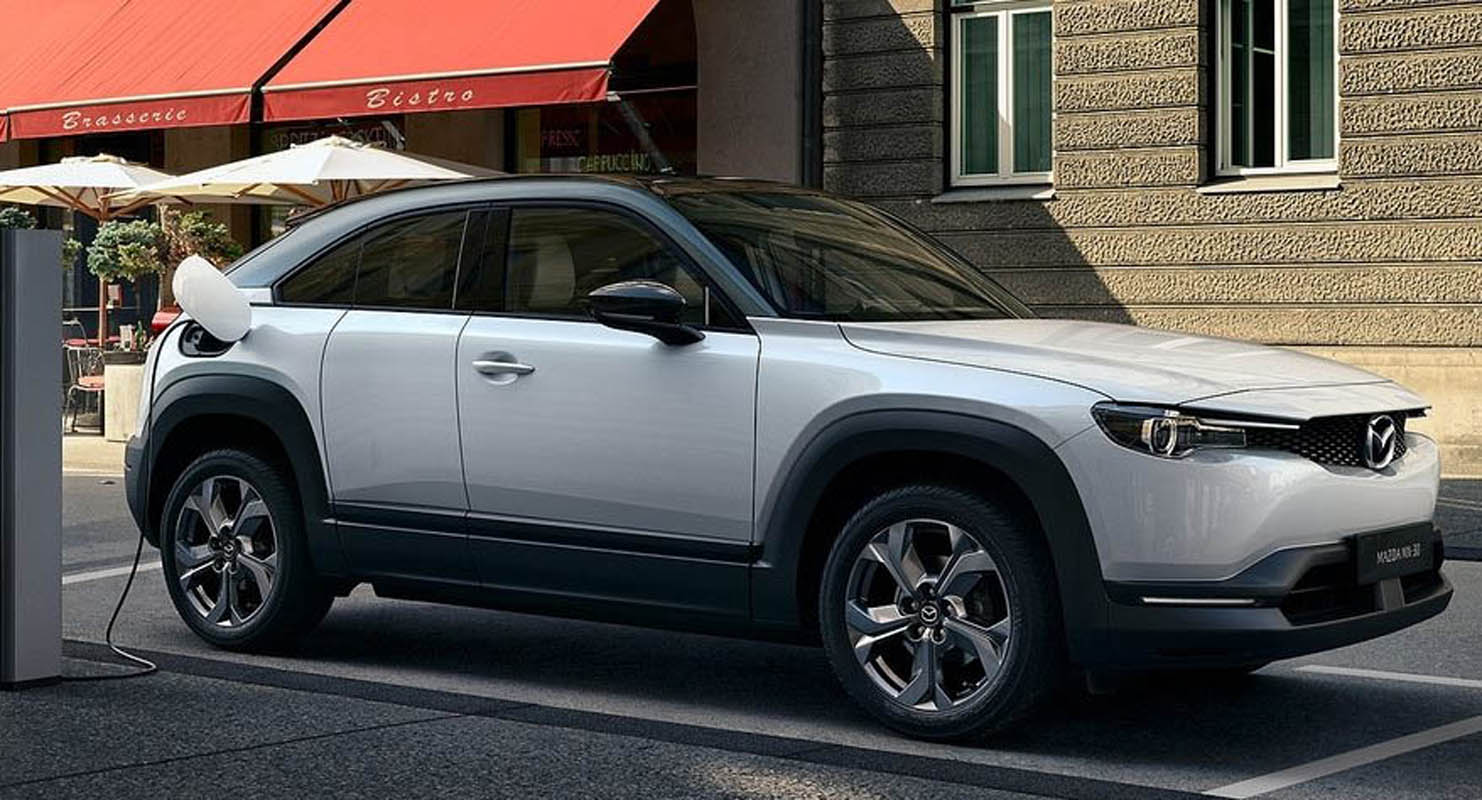
BODYSHELL
Mazda’s original bodyshell concept, which is based on a straight framework bolstered by continuous ring structures, is enhanced in the Mazda MX-30 through an increase in its rigidity and energy transmission efficiency. The vertical, lateral and longitudinal connections of the bodyshell’s multi-directional ring structures increase rigidity while reducing lag in energy transmission and maximising the function of the dampers and tires.
By concentrating energy input from the road surface in specific locations and using the damping structure that serves as a buffer material to absorb it, the body effectively reduces vibration that would otherwise cause noise, and does so without increasing vehicle weight.
Incorporating the battery pack as a part of the bodyshell’s ring structure enhances the multi-directional ring structures of its basic design by greatly increasing diagonal rigidity. Specifically, the frame that surrounds the battery pack is connected to the body in 20 locations.
Straight crossmembers sandwiching the battery pack from above and below combine with a reinforced ring structure for the rear axle mounts to significantly reduce the delay in the transmission of inputs.
In total, these measures effect a 24% reduction of the input time delay of front-to-back transmission in Mazda’s new-generation EVs versus ICE-powered vehicles, significantly increasing the controllability of the car.
SUSPENSION
The MX-30 suspension system features a MacPherson strut front and torsion beam rear set-up. By implementing the same measures as on the new Mazda3 and CX-30 – such as the use of optimised bushings and a centre beam – the smooth and instantaneous transmission of force from the road surface to the driver has been achieved.
SEATS
The MX-30’s seats have a Mazda-unique structure that supports the lower pelvis, upper pelvis and thighs to hold the pelvis in an upright position whilst simultaneously supporting the body’s centre of gravity with the upper section of the seatback. This ergonomic design helps the spine maintain a natural S-shaped curve even when seated.
Mazda has also maximised the rigidity of the seat’s internal structure and of its attachment points to the car’s bodyshell. This means that the seat moves together with the bodyshell with no delay, ensuring that input energy is transferred smoothly and instantaneously to the occupant’s pelvis, allowing them to benefit from the entirely subconscious use of their innate balancing ability.
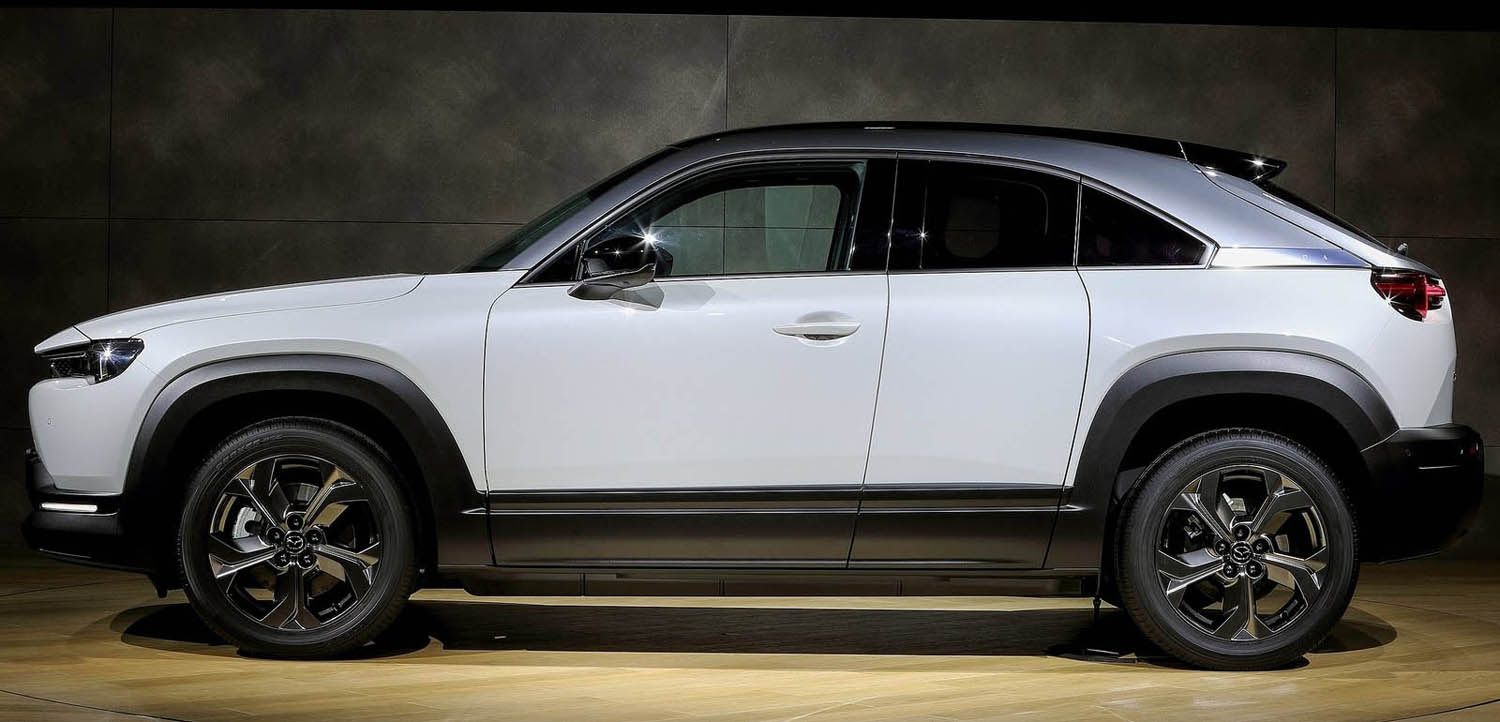
SKYACTIV-VEHICLE DYNAMICS NEW-GENERATION CONTROL TECHNOLOGIES
As distinct from the actions on an accelerator pedal, the e-Skyactiv system’s motor pedal uses Mazda’s own electric motor torque control system to realise the desired vehicle speed and posture control based on the driver’s intended amount of both acceleration and deceleration.
Closely monitoring the stroke as well as the speed of the driver’s pedal action enables the motor pedal to meet the expectations of the driver in responding with linear application of G-force. Gradual torque transition makes it easy to maintain vehicle speed when the driver operates the pedal slowly. In contrast, it interprets quick pedal operation as an indication that the driver wishes to accelerate and responds quickly by providing powerful acceleration.
Similarly, when lifting the foot from the pedal, the system monitors the speed with which the driver operates the pedal and controls the response of deceleration G-force accordingly.
Power unit mounts and other measures to increase the rigidity of the torque transmission system realise smooth and stable vehicle behaviour, even as motor torque changes from generating drive power to generating braking force. In addition, cooperative control over deceleration by the motor and brakes as the brake pedal is operated allows kinetic energy to be recovered and electricity regenerated with minimal waste.
Seamlessly connecting deceleration force as the driver moves his or her foot from the motor pedal and starts to press the brake pedal provides greater control over the front-rear load shift when cornering, or in maintaining a safe distance between the Mazda MX-30 and other vehicles when stopping.
PADDLE SHIFTERS
Rather than facilitating manual gear selection, the Mazda MX-30’s steering wheel-mounted paddle shifters add to the driving experience by enabling drivers to adjust the powertrain’s torque characteristics and the level of energy regeneration both when the motor pedal is not operated, and under braking.
These characteristics can be adjusted through five selectable settings with the paddle shifters -two levels up and two down from the default ‘D’ level, which have an impact on both the motor pedal’s on and off positions.
Regardless of the speed level selected, the only thing the paddle shifters change is the ease with which the driver can change vehicle speeds. When driving downhill, using the left paddle will result in what feels like an increase in vehicle running resistance (along with an increase in energy recuperation), enabling the driver to control the vehicle with added confidence.
Alternatively, using the right paddle when driving up steep inclines will give the feeling of a decrease in running resistance (and energy recuperation), making it easier for the driver to maintain speed. In addition, using the right paddle when driving on motorways will impede deceleration, allowing the driver to more easily travel at a set speed without straining their right foot.
The driver can also use the left pedal when driving on winding roads to extend the motor pedal acceleration control range, allowing them to enjoy easier control of load transfer when cornering.
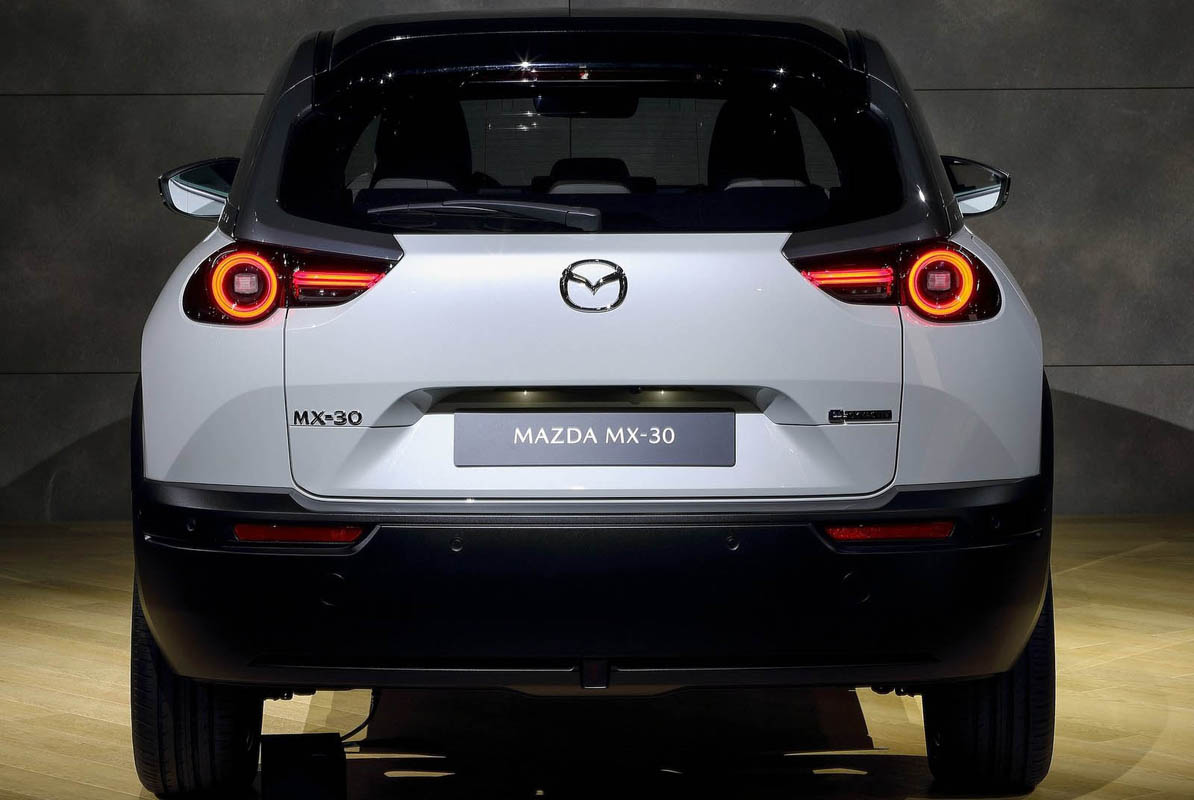
MAZDA SOUND CONCEPT FOR NATURAL SPEED CONTROL
Even though an electric vehicle produces no engine sound, Mazda’s e-Skyactiv provides aural feedback to the driver that enables him or her to subconsciously recognise the torque status of the power unit and thus control vehicle speed with greater precision.
For example, when people hear the sound of a river flowing, they can imagine the amount of water and speed at which it is flowing based solely on the sound frequency and volume.
Mazda takes advantage of this human characteristic by actively controlling sound – developed in house by Mazda -through the audio system in a way that is natural and pleasing to the driver’s ears. Synchronizing this sound to perfectly match both the motor torque and the driving situation – uphill, downhill, etc, helps not only the driver to more precisely control vehicle speed, but also all occupants to more instinctively understand the movement of the vehicle for greater on-board comfort.
ELECTRIC G-VECTORING CONTROL PLUS (E-GVC PLUS)
In the MX-30, Mazda’s G-Vectoring Control (GVC), which uses the powertrain to improve chassis performance, has evolved into e-GVC Plus. This uses the torque characteristics of the electric motor to optimise the front-rear load shift under an even wider range of driving scenarios.
In every speed range, the system achieves smooth and seamless transitions between longitudinal and latitudinal G-forces, whether the driver is making steering corrections on a straight road or cornering, to create vehicular behaviour that always feels natural and pleasing.
e-GVC Plus provides fine control over motor torque in response to the driver’s steering wheel operations. When the driver turns the steering wheel to enter a corner, the system reduces torque slightly to instigate load transfer to the front, assume a smooth turning posture, and optimise front tyre grip.
When the driver starts to return the steering wheel to its original position as the car begins to exit the corner, torque is increased slightly to shift the load to the rear and stabilise vehicle behaviour.
If the driver quickly returns the steering wheel to the neutral position, brake moment control operates in co-operation to settle cornering behaviour. As a result, it greatly improves stability when driving on mountain roads, highways and slippery surfaces.
BRAKING PERFORMANCE
Mazda’s braking performance ideal is to have braking force build gently from the instant the driver touches the pedal, and then maintain a consistent strength level. Braking force should also drop off smoothly when gently lifting one’s foot from the pedal.
Developed according to this same philosophy, the Mazda MX-30’s braking system reduces rolling resistance while increasing control. The resultant vehicle behaviour enables cabin occupants to maximise their innate ability to maintain balance for a comfortable driving experience.
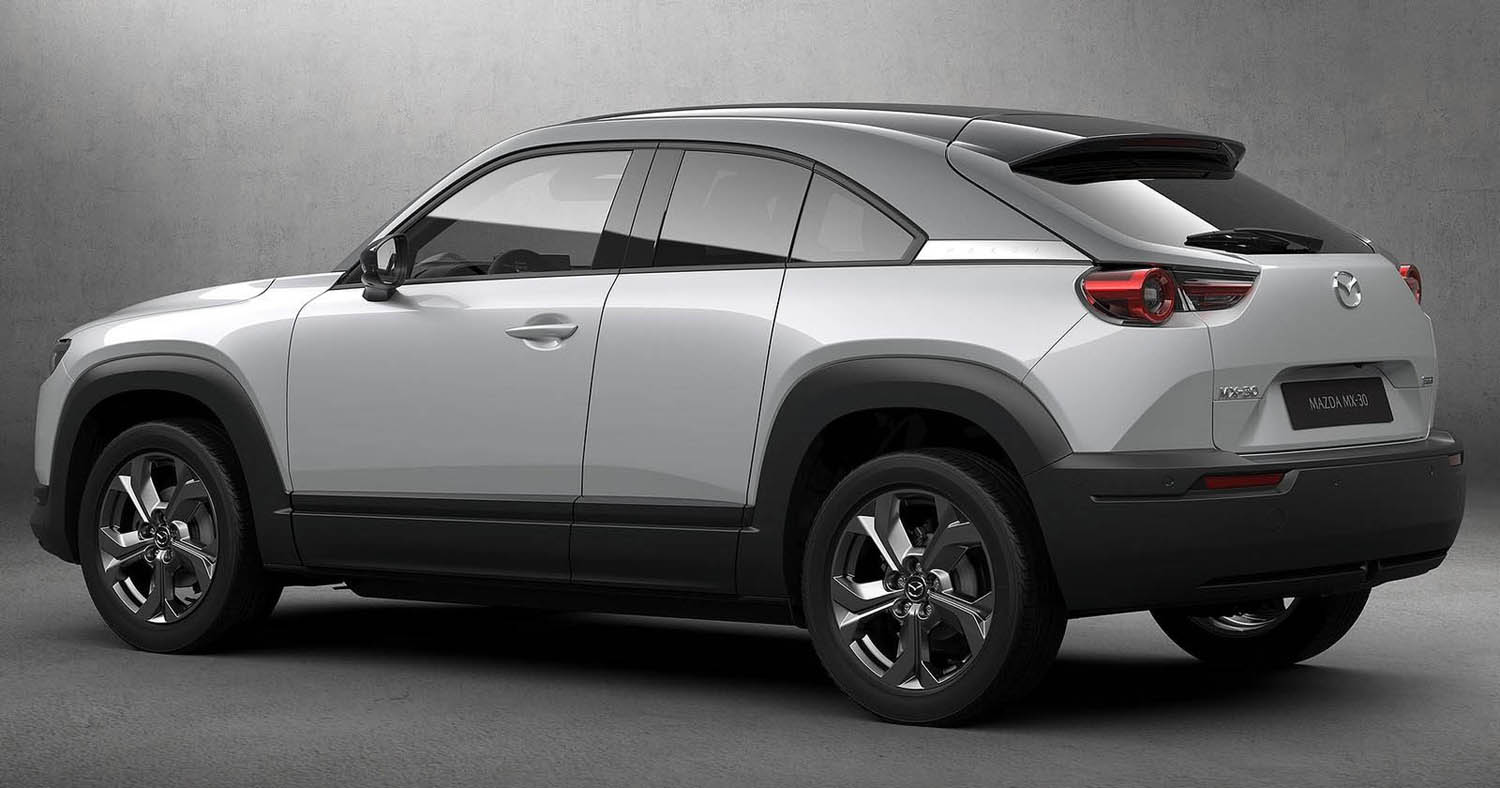
SAFETY
Dedicated to helping achieve an accident-free automotive society, Mazda’s Proactive Safety philosophy guides all of the company’s safety performance research and development. With safety fundamentals such as the driving position at its core, this philosophy drives the ongoing evolution of Mazda’s advanced i-Activsense active safety technologies and passive safety features.
The MX-30 features a further enhanced suite of i-Activsense features1. Turn-Across Traffic functionality has been added to the existing Smart Brake Support (SBS) system to help prevent collisions when turning across traffic at intersections.
New technologies include Emergency Lane Keeping with Road Keep Assist, which helps keep the car on the right track even in the absence of lane markings, and Emergency Lane Keeping with Blind Spot Assist, which helps prevent collisions when changing lanes.
Despite adopting Mazda’s centre-pillar-less freestyle door system, the MX-30 offers occupants excellent passive safety performance through a rigid bodyshell and structures that efficiently absorb collision energy.
ACTIVE SAFETY: I-ACTIVSENSE
SBS adds a new Turn-Across Traffic function to the vehicle-, pedestrian-, night-time pedestrian- and bicyclist-monitoring functions already built into the system. When turning left at an intersection, (in left-hand drive vehicles), the forward-sensing camera and millimetre wave radar sensors monitor oncoming traffic.
When the system determines there to be a chance of a collision occurring, it automatically applies the brakes to help prevent impact or mitigate damage that may occur. Programmed to monitor nearby vehicles, the function only operates at low speeds.
Road Keep Assist
When travelling at speeds of over approximately 60km/h, the forward-sensing camera monitors curbs, grass and other natural verges along the edges of unmarked roads. When the system determines there to be a chance of the vehicle drifting off the road, it assists the driver with preventative steering operations.
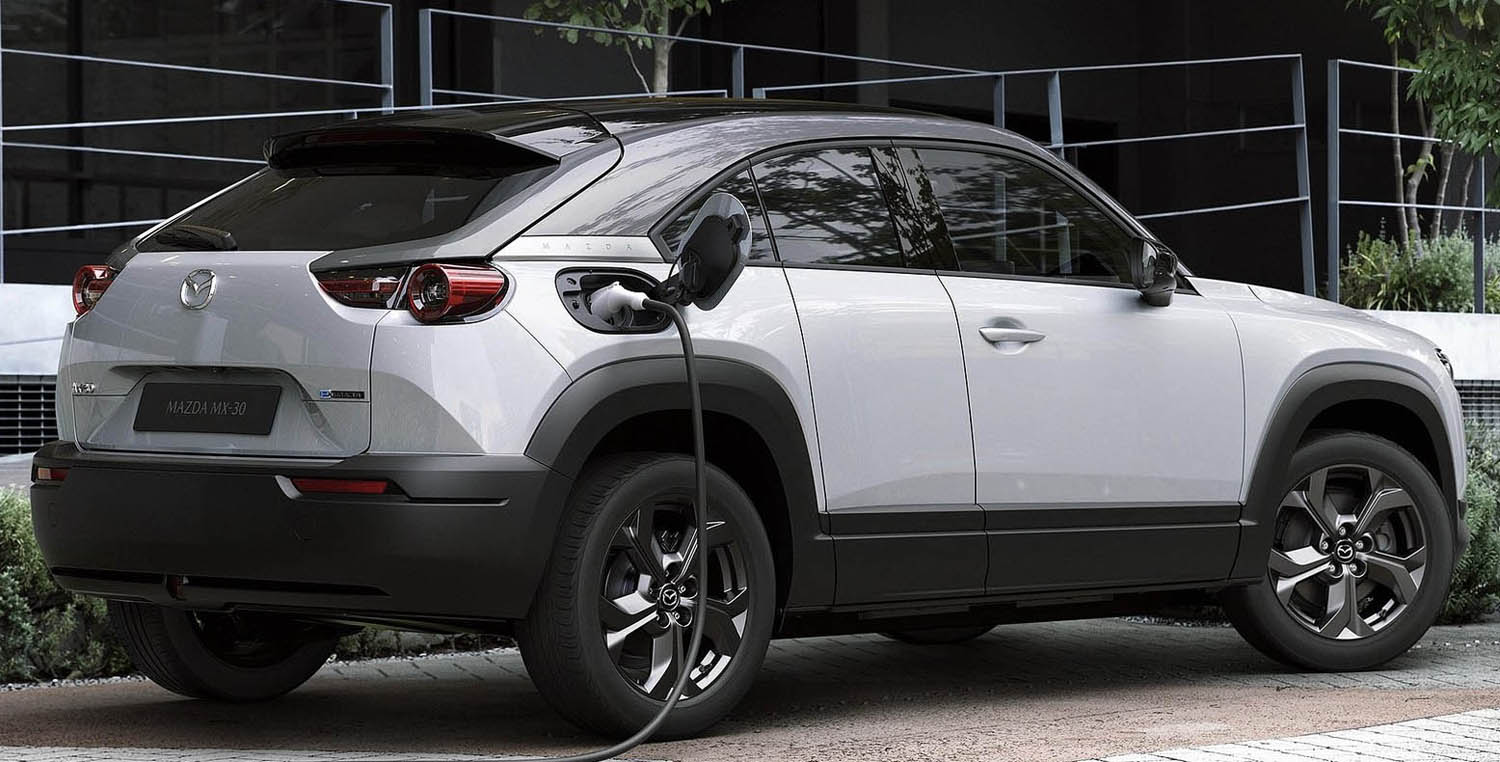
Blind Spot Assist
The system uses 24GHz millimetre wave radar sensors to monitor the areas behind and to the sides of the car when travelling at speeds of over 60km/h. If the driver steers to change lanes when there is a threat of colliding with a vehicle approaching from the rear, the system assists steering operations to help prevent impact or mitigate damage that may occur.
Available i-Activsense Systems on the Mazda MX-30
- Accident prevention and damage mitigation
- Smart Brake Support (SBS) with Turn-Across Traffic
- Smart Brake Support [Rear] (SBS-R)
- Smart Brake Support [Rear Crossing] (SBS-RC)
- Support for potential hazard awareness
- Adaptive LED Headlights (ALH)
- High Beam Control (HBC)
- 360° View Monitor
- Front Cross Traffic Alert (FCTA)
- Blind Spot Monitoring (BSM)
- Rear Cross Traffic Alert (RCTA)
- Lane Departure Warning System (LDWS)
- Lane-keep Assist System (LAS)
- Emergency Lane Keeping with Road Keep Assist
- Emergency Lane Keeping with Blind Spot Assist
- Driver support
- Traffic Sign Recognition System (TSR)
- Intelligent Speed Assistance (ISA)
- Driver Attention Alert (DAA)
- Driver Monitoring
- Mazda Radar Cruise Control (MRCC)
- Cruising & Traffic Support (CTS)
PASSIVE SAFETY
To protect cabin occupants in the event of a collision, the Mazda MX-30’s centre-pillar-less construction incorporates a process by which hot-stamped material is first attached to the multifaceted reinforcing material before both are formed together into the A-pillar and roof side shapes.
Extensive use of 1,310 MPa-class and other ultra-high-tensile steel combines with efficient energy-absorbing structures throughout. In addition, aiming to combine high-level collision safety with the freestyle door system, hot-stamped vertical reinforcements are positioned inside the rear doors.
The result is a structure that absorbs and effectively diffuses impact energy from side collisions. Reinforcement of the front and rear door hinges, as well as the side sills, has realised body strength and energy-absorbing efficiency on a par with cars that have centre pillars.
The Mazda MX-30 also adopts a safety system that shuts down the flow of drive system power the instant a collision is detected. In addition, the battery packs are encased in high-strength material and surrounded by a rigid frame. This design offers the batteries solid protection, which in turn protects cabin occupants from potential secondary injuries caused by exposure to high-voltage power.
